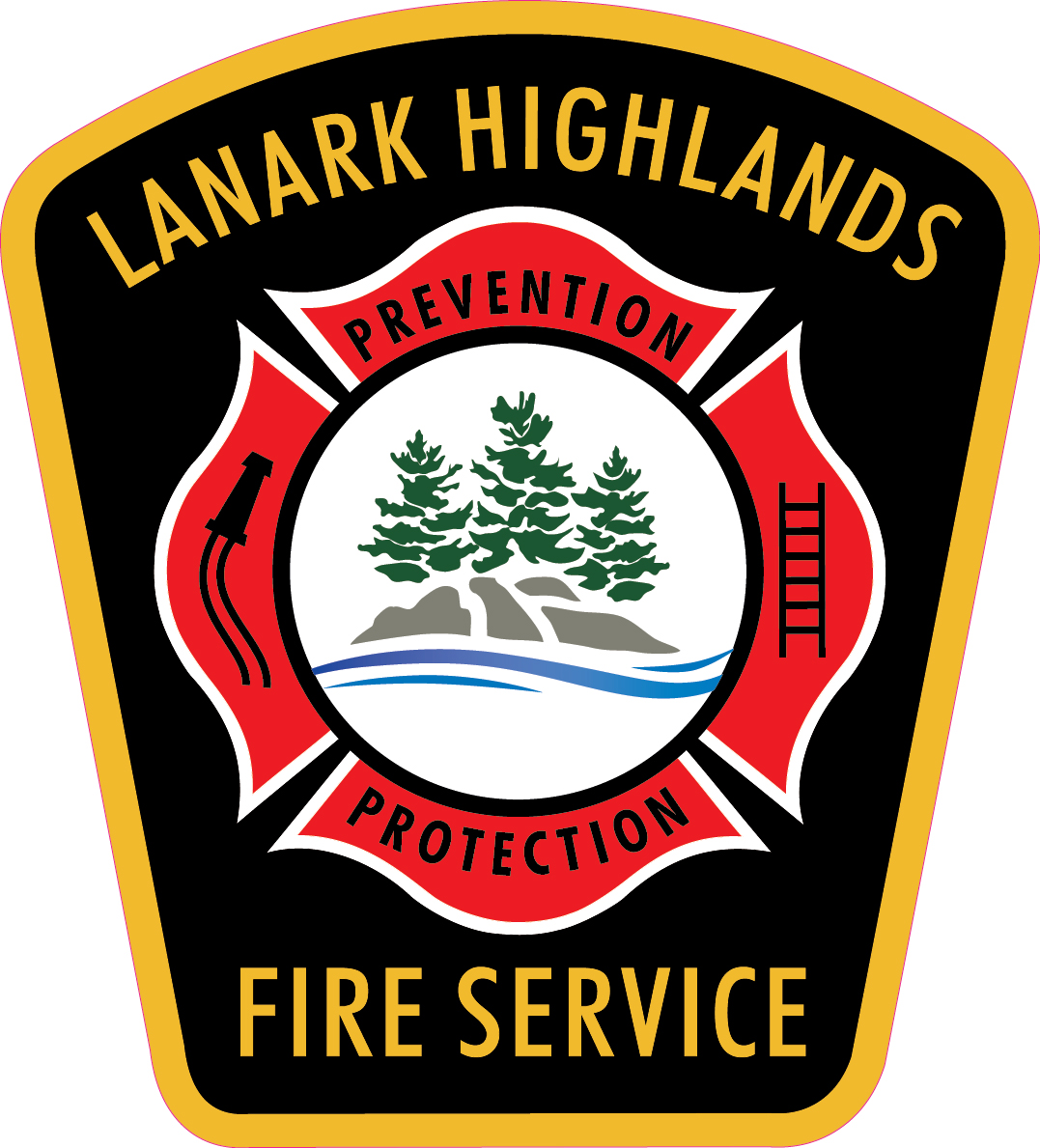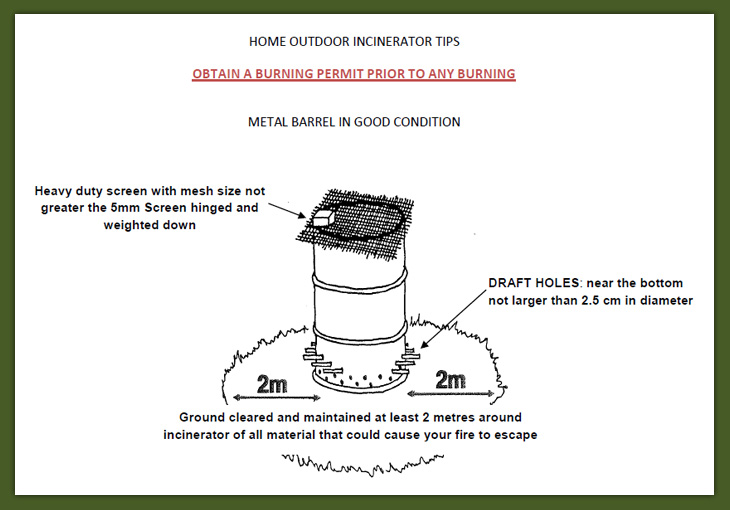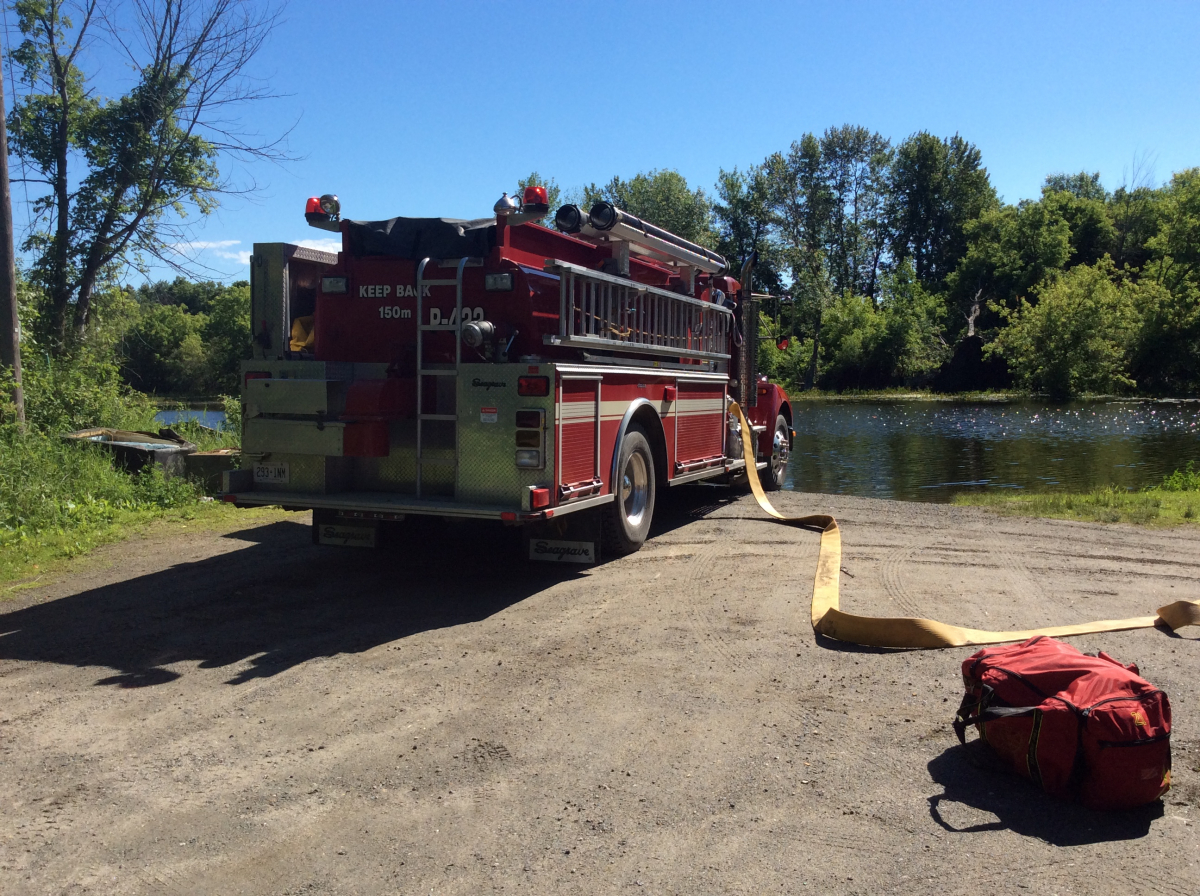In an Emergency, always call 9-1-1
Lanark Highlands Fire Department
75 George Street, Box 340
Lanark, Ontario K0G 1K0
Office Hours
Monday-Friday 9:00 a.m. – 4:00 p.m.

The Lanark Highlands Fire Department consists of 70 highly trained volunteers under the direction of a full time Fire Chief. The Lanark Highlands Fire Service was formed in 1997 with the amalgamation of 5 individual departments. (presently)
- Lanark Village (Station #1)
- Lanark Township (station #2)
- Lavant Dalhousie and North Sherbrooke Township (Station #3)
- Darling Township (Station #4)
The Lanark Highlands Fire service is one of nine municipalities within Lanark County and are part of the Lanark County Mutual aid System. We have automatic aid and fire service agreements in place with Neighbouring municipalities.
The municipalities of Drummond North Emsley and Tay Valley to the south west/east, McNab Braeside to the north east, Lanark Highlands covers 1,048.83 square kilometres. The township boarders two other counties, Renfrew to the north and Frontenac to the west.
Fire Permits
- Fire Permits are available for purchase ONLINE.
- Fire permits are required for ALL burning.
- Fire Permits are valid ONLY for the year of issue.
- Fire permits must be renewed prior to burning.
- Please call 1-844-465-0303 to initiate a burn event. Information such as Fire Risk and Fire Ban status will be advised in the message.
- You must call ahead to initiate fires which are larger than 3.25 feet (1 m) in diameter. Small recreational fire pits DO NOT require activation.
- Cost: $5.00
PLEASE NOTE that if residents are unable to purchase a burn permit online, Township staff is available to provide assistance, either by phone at 613-259-2398 ext. 242 or in person at our Township Office.
April 1st – October 31st – Provincial Fire Season
As per section 2 of Ontario Regulation 207/96, no person shall start or tend a fire outdoors of a restricted fire zone during the fire season unless the person has a permit issued under subsection 5(1) and ALL of the following conditions are met:
- The person is burning piled wood, brush, leaves, or discarded wood products
- A responsible person is available to tend the fire until it is extinguished
- The material is burned in a single pile that is less than 6.5 feet in height and is less than 6.5 feet in diameter
- The fire is started no earlier than two hours before sunset and is extinguished no later than two hours after sunrise the following day.
- The fire is at least 6.5 feet from any flammable materials
- The person tending the fire has tools or adequate water to contain the fire, within the fire site. O. Reg. 230/00 s. 1.
November 1st – March 30th
A fire constructed to the following standards:
- The person is burning piled wood, brush, leaves, or discarded wood products
- A responsible person is available to tend the fire until it is extinguished
- The fire is at least 6.5 feet from any flammable material
- The site of the fire is bare rock or other non-combustible material
- The space above the 3.25-foot area around the fire is at least 10 feet from vegetation
- The fire does not exceed 6.5 feet in height and 6.5 feet in diameter
- The person in control of the fire has sufficient means to extinguish the fire
Cost: $5.00
Fire Permits are available to purchase ONLINE.
If assistance is required to purchase a burn permit, please contact Township staff by phone at 613-259-2398 ext. 242 or in person at our Township Office.
PLEASE NOTE that the Township of Lanark Highlands will no longer be offering the purchase of Burn Permits at remote locations.
Fire Permits can be renewed annually by visiting the BurnPermits website
Fire Permits are valid for a calendar year (January 1 - December 31)
Fire Safety and Prevention
New Carbon Monoxide Alarm Rules Come into Effect January 1, 2026
New Carbon Monoxide Alarm Rules Effective January 1, 2026:
Homes with any fuel-fired appliance, fireplace, attached garage, or that is heated by air from a fuel-fired appliance that is not contained within your home - MUST have carbon monoxide alarms on every level, including basements and floors without sleeping areas.
The above requirements will apply to multi-unit residential buildings, including apartments, condominiums, hotels, motels, and retirement homes, as well as buildings where residents require assistance to evacuate, such as long-term care facilities.
What is Carbon Monoxide (CO)?
Carbon monoxide (CO) is an invisible, tasteless and odourless gas that is produced when fuels such as propane, gasoline, natural gas, heating oil and wood do not burn completely in fuel-burning appliances and devices, such as: furnaces, fireplaces, hot water heaters, stoves, barbeques, portable heaters, generators and vehicles.
Exposure to CO can cause headaches, nausea, dizziness, confusion, drowsiness, loss of consciousness and even death.
Where Should Carbon Monoxide Alarms be Installed?
In all Residences:
- CO alarms are required outside each sleeping area and as of January 1, 2026, on every level of the home.
For example: if bedrooms are on the same floor but far apart (on opposite sides of a living room) you need two CO alarms on that floor - one outside each group of bedrooms.
Where a building has an attached garage, you must install CO alarms:
- Next to each sleeping area in any apartment or unit that shares a wall, floor, or ceiling with the garage.
- On every level of those same units that doesn’t have a sleeping area.
Where a building is heated by a forced-air fuel-burning appliance that’s not inside a home or care unit, you must install CO alarms:
- In the service room or area where the appliance is located (if it’s in a building).
- In any hallway heated by the appliance:
- At least one alarm in each section if the hallway is divided and alarms spaced no more than 25 metres apart in undivided hallways.
- Next to each sleeping area in any unit heated by the appliance.
- On every level of those same units that doesn’t have a sleeping area.
Carbon Monoxide Alarm Maintenance and Safety
- CO alarms should be tested monthly – this is easily done by pushing the TEST button.
- Batteries should also be replaced at least once per year.
- Be sure to check the expiration date of all CO alarms in your residence. If there is no expiration date or you are unsure of your alarm’s expiration date, the alarm should be replaced.
- It is recommended that CO alarms are replaced every 7-10 years.
As per the Ontario Fire Code, a CO alarm MUST meet one of the following standards:
- CSA-6.19, Residential Carbon Monoxide Alarming Devices
- UL 2034, Single and Multiple Station Carbon Monoxide Alarms
CO alarms may be hardwired, battery-operated, or plug-in. Combined smoke and CO alarm devices are also permitted. Always follow the manufacturer’s instructions on how to correctly install your CO alarm.
Landlords are responsible for:
- Installing and maintaining CO alarms in their rental units.
- Testing CO alarms in rental units in the following situations: annually; when the battery is replaced; when changes are made to the electric circuit; or there is a change of tenancy.
- Providing the tenant with a copy of the carbon monoxide alarm’s maintenance instructions.
Tenants should test CO alarms monthly and must notify the landlord of any issues or concerns.
It is against the law for tenants to remove the batteries or tamper with CO alarms in any way.
Safety Tips:
- Remove vehicles from the garage immediately after starting.
- Shovel snow away from exhaust pipes, dryer vents and intakes for fuel burning appliances.
- Use generators or other gas equipment in a well-ventilated location, ideally outdoors away from windows, doors or vent openings.
- Book an annual inspection and cleaning for furnaces, chimneys and fireplaces; gas dryers; stoves; and any other fuel-burning equipment.
- Never use gas appliances such as ranges, ovens or clothes dryers to heat your home.
- Never use a barbecue or portable fuel-burning camping equipment inside.
For more information regarding carbon monoxide safety please view the following link:
Is Your Wood Stove Safe?
Improperly installed and maintained wood stoves and fireplaces can lead to dangerous conditions that put you, your family, and neighbours at risk.
Follow the rules – When purchasing a new wood stove or fireplace insert, look for the mark of an accredited certification agency that ensures the product has been tested and meets established safety standards.
Check with your local building department and obtain any necessary permits prior to installing a wood stove, fireplace insert, or chimney. Always follow the manufacturer’s installation instructions.
The Ontario Fire Code requires homeowners to ensure that their home heating appliances and chimneys are safe. This requires periodic inspections and maintenance.
Tips for maintaining your wood burning appliance
- Inspect and Clean your Chimney
- Check your chimney and clear any obstructions at the start of the heating season, and make sure damper controls work properly to keep smoke and toxic gases from building up inside the home.
- Check chimneys and flue pipes often for creosote and soot build-up and clean to prevent a chimney fire.
- Your chimney may have problems you can’t see. If in doubt, consult a WETT (Wood Energy Technical Training) certified chimney sweep.
- Cap It Off
- Maintain an appropriate chimney cap on top of your chimney to protect against damage from rain or snow.
- Spark screens should be inspected regularly to make sure smoke can vent properly.
- Check Stove Pipes and Connections
- Ensure all joints in flue pipes are securely fastened with at least 3 screws. Where flue pipes are joined together, the small (crimped) end should point toward the appliance.
- Protect Floors and Walls from Heat and Sparks
- Keep combustible materials a safe distance away from wood stoves and fireplaces.
- Always use a properly fitting screen for your fireplace.
- Consult a WETT certified chimney sweep if walls get too hot.
- Burn Dry Wood
- Burn properly dried well-seasoned wood to reduce the risk of excessive creosote build-up from inefficient burning or smoldering fires.
- Store wood outdoors, stacked in an open area or shed away from the house or deck to provide good air flow that will assist drying.
- Remove Ashes Safely
- Allow ashes to cool fully before cleaning them from your fireplace or wood stove.
- Use only metal, non-combustible containers to remove ashes from the appliance.
- Take them outside immediately and store well away from buildings on a non-combustible surface.
- Install Carbon Monoxide Alarms
- All homes with fuel-fired appliances should have a carbon monoxide (CO) alarm. Check with your fire department or municipal office regarding Building Code and municipal by-law requirements.
In Ontario, all residences must have a working smoke alarm on every level AND outside every sleeping area.
If your home or residence was built after 2014 you must have a working smoke alarm on every level and IN every sleeping room. The smoke alarms must be interconnected, have a battery backup (that lasts for at minimum 7 days if power is lost) AND have a visible strobe light.
For Rental Units it is the landlord’s responsibility ensure that there are working smoke alarms in each unit. Renters are responsible for testing smoke alarms once monthly and to report any issues to their landlord immediately.
Smoke alarms must be tested monthly – this is easily done by pushing the TEST button. Batteries should be replaced at least once per year.
Be sure to check the expiration date of all smoke alarms in your residence. It is recommended that smoke alarms are replaced every 7-10 years. If there is no expiration date or you are unsure of your alarm’s expiration date, the alarm should be replaced.
For false alarms, use the HUSH button – IT IS AGAINST THE LAW TO DISABLE A SMOKE ALARM. If the alarm is beeping, try cleaning the alarm or replacing the battery. Move or replace the alarm if it is too close to a kitchen, bathroom or heat register.
Replace defective smoke alarms as soon as possible
Types of Smoke Alarms:
Ionization – Fastest type to respond to flaming fires.
Photoelectric- Fastest type to respond to a slow smoldering fire and white or gray smoke, less prone to nuisance alarms from cooking, mist or steam from showers.
Quick Tips:
• Smoke alarms must be installed on or near the ceiling, be sure to follow all manufacturers’ instructions.
• Upgrade to interconnected smoke alarms – if one goes off, they all go off, giving warning wherever you are in your home.
• Choose hardwired smoke alarms that require a backup battery or alarms with a 10-year sealed battery.
• Sleep with bedroom doors closed.
Portable fire extinguishers can help to save lives and property by extinguishing or helping to contain small fires until the fire department arrives.
The number one priority in any fire is always for residents to get out safely – Fire can grow and spread quickly – Please call your local fire department immediately for any fire.
When to use a Fire Extinguisher:
- Everyone has safely exited the building.
- When a fire is contained to a small area, such as a wastebasket.
- The fire is not growing.
- The fire department has been called or is being called.
- The room is not filled with smoke.
Types of Fire Extinguishers:
- Class A – Ordinary combustibles (wood, paper)
- Class B – Grease, gasoline and oils
- Class C – Burning electrical wires
Select a multi-purpose extinguisher labeled ABC which can be used on all types of home fires. Purchase an extinguisher that is large enough to put out a small fire, and light enough to easily use. The fire extinguisher should carry the label of an independent testing laboratory (CSA or ULC). Fire extinguishers should be installed near an exit, in a visible and accessible location. Always follow the manufacturer’s directions for operating and taking care of a fire extinguisher. The pressure gauge should be checked once monthly.
It is safe to use a Fire Extinguisher if:
- The fire is contained to a small area and is not spreading beyond the area immediately surrounding it.
- There is an unblocked escape that you can use where the fire won’t spread.
- You have read and understand the operating instructions and are confident using the fire extinguisher.
How to use a Fire Extinguisher:
Stand approximately 2.5 metres (8 feet) from the fire and keep your back to a clear exit. If the room begins to fill with smoke, leave immediately staying low until safely outside.
To operate a fire extinguisher, remember the word PASS
- Pull the pin, and hold with the extinguisher nozzle pointing away from you. Give a test squeeze to make sure the extinguisher is working properly before approaching the fire.
- Aim low and point the extinguisher at the base of the fire.
- Squeeze the lever slowly and evenly.
- Sweep the nozzle from side to side.
IF THE FIRE DOES NOT IMMEDIATELY GO OUT, EXIT THE AREA AT ONCE
How to Build a Safe Incinerator
If you burn forest litter or debris often, build and use a good incinerator.
- Select a site at least five metres from anything that could catch on fire, like trees, overhanging branches, or piles of debris. Clear an area two metres around the incinerator down to mineral soil.
- Use a metal barrel in good condition
- A heavy metal mesh must be put on top of the incinerator. Mesh size must be less than five mm. Weight the screen with a rock or brick to stop it from falling off your incinerator. Without a mesh cover, a hot fire can spread burning sparks.
- Material will burn more quickly and cleanly if the incinerator has good air flow. To create this, punch holes about seven centimeters above the bottom of the barrel. Punch a few more holes slightly higher and insert steel rods or pipes to support the material to be burned.
- Keep a shovel, rake and water nearby.
- Monitor any fire burning in the incinerator.

Always follow safe campfire practices to prevent your campfire from starting a forest fire. Remember, you could be held responsible for the cost of putting out the forest fire, and for any property damage.
Choose your site carefully
Select a site with easy access to water, sheltered from prevailing winds. Look for a patch of sand or gravel (mineral soil). An area of bedrock is even better.
Your fire should be at least three metres away from any log, stump or overhanging tree, and 15 metres away from any buildings or forest debris that might catch fire. If you make a circle of rocks around your fire make sure the rocks to not hide hot coals after you leave.
Preparing the site
Start by cleaning a one metre space around your campfire site. Remove all pine needles, grasses, leaves and twigs. Scrape away the surface area, right down to mineral soil.
Keep you fire small. You can always add more fuel as you need it. A smaller fire will keep your cooking tools from blackening and let you get close enough to cook. Remember that the forest is no place for a bonfire, and a small fire is easier to control and put out.
Stay nearby
Never leave your campfire unattended. Every person who starts a fire outdoors must:
- take all reasonable steps to keep the fire under control;
- ensure that responsible person is tending the fire at all times;
- drown the fire before leaving the site of the fire for any period of time whatsoever.
How to put your fire out
Begin by thoroughly drowning your fire with water as soon as possible after use. The ground will cool faster and the hazard to surrounding trees or shrubs will be greatly reduced.
Stir the ashes with a stick to uncover hot coals. This will cool the fire faster and allow water to soak in better. Move the rocks to uncover embers.
Drown it again! Make doubly sure the fire is dead out before you leave the site or retire for the evening.
Each year, hundreds of lives are lost because emergency vehicles could not arrive on scene fast enough. Common causes for this are no PIN numbers, private lanes not adequately marked, and lack of access for emergency vehicles.
Tips to allow emergency responders to find your home or cottage:
- Ensure your PIN Number clearly identifies your home or cottage. If you don’t have a PIN number, contact the Township Municipal Office at 613-259-2398 to arrange for installation.
- Ensure laneways and private drives direct responders to your home. It may be necessary to install a second pin number tree or post directing responders down a lane to find your PIN number. If you believe that emergency responders would benefit from this secondary identification, please call the Township office at 613-259- 2398
- Send help to access points that emergency vehicles will arrive by. Provide directions for responders.
- It is the owner’s responsibility to ensure private laneways are plowed with limbs and trees cleared to a minimum width of 6 metres with overhead clearance of 5 metres. Turns and corners must be wide enough to allow trucks to drive directly to the building.
Limited Access May Affect Emergency Response
It is important that a fire truck or ambulance be able to use your laneway when responding to an emergency call at your house or cottage.
The owner of a building in the Township of Lanark Highlands is responsible for the access to the building from the traveled portion of the road to the building.
An access that is not suitable for a large pumper truck or ambulance may affect the effectiveness of emergency personnel responding to an emergency call at that location.
Laneways should be snowplowed and cleared of limbs or trees to a minimum width of 6 metres with a clearance of 5 metres overhead. Any turns or corners must be wide enough to allow the trucks to drive directly to the residence.
Here are some tips offered by the Office of the Fire Marshal and the Township of Lanark Highlands Fire Service on Fireworks Safety to keep you and your family safe:
- Check with your local Fire Department during Fire Bans
- Always follow the label directions
- Never make your own fireworks
- The shooter should always wear protective eye glasses or protection for their hands
- Fireworks are meant for outdoor environments only
- Have an adult present to light them
- Discharge fireworks well away from combustible materials like buildings, trees and dry grass
- Discharge fireworks only if wind conditions do not create a safety hazard
- Always have water handy when lighting fireworks (ie: a garden hose) you can also use sand in a bucket if need be to put them out.
- Only light one at a time. Never attempt to re-light fireworks that have misfired (duds). Wait 30 minutes and then place them in a bucket of water.
- Never throw/point fireworks at other people
- Sparklers burn extremely hot and can ignite clothing, cause blindness and result in severe burns. As the sparkler wire remains hot for some minutes after burnout, it should be immediately soaked in water to avoid injury


